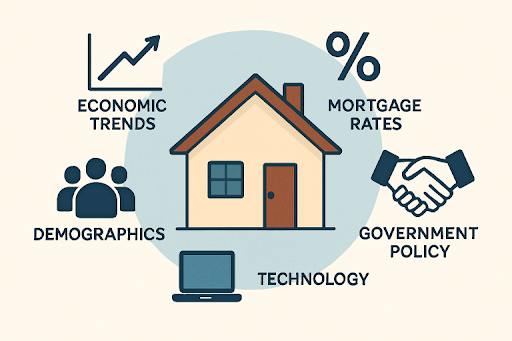Table of Contents
- Introduction
- Economic Indicators and Their Impact
- Interest Rates and Mortgage Affordability
- Supply and Demand Dynamics
- Consumer Confidence and Buying Behavior
- Technological Advancements in Real Estate
- Demographic Shifts and Housing Preferences
- Government Policies and Incentives
- Conclusion
Understanding how housing market trends shape your home-buying journey is invaluable in today’s dynamic real estate environment. Economic conditions, changing buyer priorities, and technological innovations all shape when and how people purchase their homes. As buyers consider their options, staying up to date on regional opportunities like homes for sale in Pasadena can make the difference between a smart investment and a missed opportunity. Whether you’re a first-time homebuyer or a seasoned investor, recognizing what drives market shifts enables you to act confidently and strategically. Key trends—ranging from fluctuating mortgage rates to demographic-driven preferences—continually redefine the meaning of affordability, value, and the ideal location. Navigating these trends empowers homebuyers to match their goals with the realities of today’s housing market.
Economic Indicators and Their Impact
Economic health continues to be a primary driver of housing market stability and growth. When employment rates are high and GDP is rising, households typically have more financial confidence, leading to increased demand for homes. Recent improvements in employment numbers have correlated with subtle upswings in home purchases. Conversely, during periods of economic uncertainty or recession, buyers may hesitate, leading to slower market activity and even temporary price corrections. Inflation also plays a significant role in housing affordability and buyer caution. As everyday costs rise, disposable income shrinks, potentially curbing enthusiasm for taking on new mortgages. Monitoring these economic indicators helps potential buyers gauge the right time to enter the market, and even the types of properties—urban condos vs. suburban single-family homes—that might best hold their value.
Interest Rates and Mortgage Affordability
Mortgage rates are among the top concerns for homebuyers evaluating affordability. When rates are low, monthly mortgage payments decrease, making it possible for buyers to stretch their budgets or consider more desirable neighborhoods. Low interest rates in past years sparked intense competition and quickly rising home prices, but as rates have ticked upwards, affordability has become a more pressing obstacle. Higher interest rates can dissuade buyers from entering the market, as they not only increase monthly payments but also reduce borrowing capacity. Recent mortgage rate hikes have led to a nationwide slowdown in home sales, highlighting the deep ties between macroeconomic policy and buyer confidence.
Supply and Demand Dynamics
The relationship between the number of homes available (inventory) and the number of buyers significantly shapes local and national markets. A lack of available homes means that buyers often find themselves in competitive bidding wars, driving up sales prices and sometimes pushing potential homeowners out of their preferred markets. Conversely, when there is an oversupply of houses, buyers may benefit from falling prices and improved negotiating leverage. Regional differences also reflect supply-demand imbalances. While some markets transition into buyer-friendly territory, others, particularly in high-growth areas, remain firmly in seller’s market territory due to persistent inventory shortages. Tracking regional housing reports can help buyers make educated decisions about where their money goes furthest.

Consumer Confidence and Buying Behavior
Consumer sentiment is an often-overlooked but crucial housing market driver. When people feel secure in their jobs and optimistic about the future, they are much more likely to commit to a home purchase. A drop in consumer confidence—due, perhaps, to volatile stock markets or global events—will usually translate into more cautious buying behavior and lower transaction volume. Monitor consumer sentiment indices, such as those by Reuters US Markets, to gauge the general mood and anticipate shifts in purchasing activity. These numbers can provide valuable insight into whether the housing market is about to heat up or cool down in the near term.
Technological Advancements in Real Estate
Technology continues to reshape the way buyers search for, evaluate, and purchase homes. With the rise of virtual tours and comprehensive online listings, it is now possible to view dozens of homes from virtually anywhere, streamlining the process and expanding options for out-of-area buyers. Digital closings and e-signatures further reduce friction, making the process faster and more convenient for all parties involved. This digital transformation has benefited both buyers and sellers. For buyers, technology introduces greater transparency, more detailed comparison tools, and access to educational resources, all of which contribute to smarter, more confident purchasing decisions.
Demographic Shifts and Housing Preferences
Demographics—such as the rise of remote work and shifting generational priorities—play a powerful role in shaping housing markets. Millennials, now in their prime home-buying years, often prefer walkable neighborhoods, energy-efficient homes, and urban amenities. In contrast, baby boomers may seek properties that enable aging in place, often looking towards quieter suburbs or smaller towns for retirement. The remote work revolution has also spurred a notable migration away from expensive urban centers to more spacious and affordable regions. This shift has rebalanced demand across the country and is prompting developers and city planners to rethink future housing needs.
Government Policies and Incentives
Governmental action—whether tax credits, down payment assistance, or zoning reforms—remains a key lever in housing affordability and supply. Programs for first-time buyers or incentives for energy-efficient renovations attract a wider range of buyers and stimulate market activity. Meanwhile, policy decisions at the local level, such as changes to zoning laws, can influence the speed and scale of new home construction, ultimately impacting supply and long-term prices. Staying abreast of proposed and active government programs helps buyers unlock cost-saving opportunities and anticipate market shifts that could affect their decisions down the road.
Conclusion
Any prospective buyer must thoroughly understand the trends that drive housing market fluctuations. By closely watching economic indicators, mortgage rates, inventory levels, consumer sentiment, technological advancements, demographic changes, and government policies, buyers position themselves for success. Informed decision-making, timely action, and a clear view of both the local and national market can help aspiring homeowners achieve their dreams with greater reliability and peace of mind.



